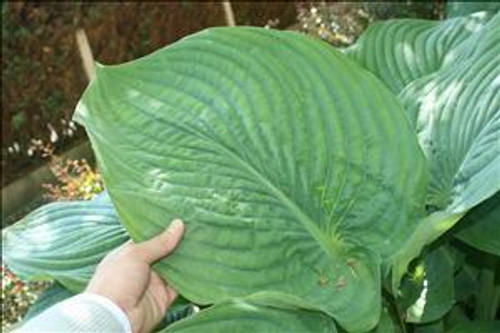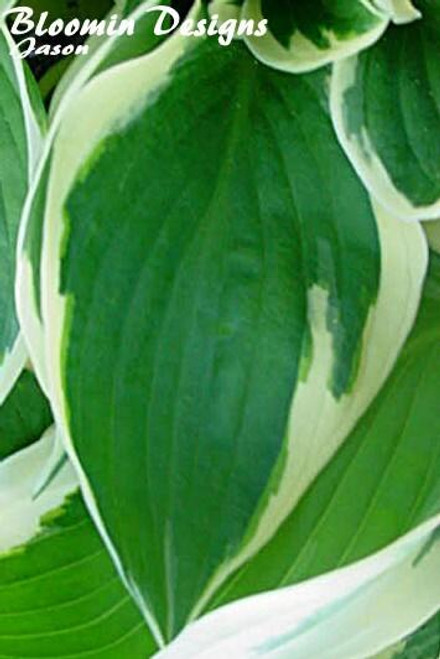Product Description
'Empress Wu' Hosta (Skaggs 2008) (4) 1-gallons
Hosta 'Empress Wu' is a truly majestic and aptly named hosta, renowned for its massive size and impressive presence. This giant among hostas boasts huge, heart-shaped, slightly corrugated leaves that emerge a beautiful blue-green and mature to a deeper, more substantial green. 'Empress Wu' forms a magnificent, mounding clump, creating a dramatic focal point in any shade garden. It is a slow grower, but its impressive mature size makes the wait worthwhile. In midsummer, 'Empress Wu' produces tall, sturdy scapes topped with pale lavender to near-white flowers that rise high above the foliage, adding to its regal appearance.
Details:
- Mature Size: 3-4 feet tall, 5-6 feet wide (can be even larger in ideal conditions)
- Leaf Size: 18-24 inches long, 14-18 inches wide (or larger)
- Flower Color: Pale Lavender to Near-White
- Bloom Time: Midsummer
- Growth Habit: Mounding
- Sunlight: Partial Shade to Full Shade
- Soil: Moist, well-drained
- Hardiness Zones: 3-9
Planting and Care:
- Planting: Choose a location with partial to full shade and moist, well-drained soil. Amend the soil with plenty of compost or other organic matter before planting. Dig a large hole, significantly larger than the root ball, and plant at the same depth as the container. Give this hosta plenty of room to grow!
- Watering: Keep the soil consistently moist, especially during dry periods. Water at the base of the plant to avoid wetting1the leaves, which can increase the risk of fungal diseases.
- Fertilizing: Apply a balanced fertilizer in early spring as new growth emerges. Avoid over-fertilizing.
- Mulching: Mulch around the plants with shredded bark, compost, or pine needles to retain moisture, suppress weeds, and protect the crown.
- Pest and Disease Control: Be vigilant for slugs and snails, which can be a major threat to hostas, especially young plants. Use appropriate control measures like slug bait or traps. Hosta Virus X (HVX) is also a potential issue; purchase plants from reputable sources and discard any plants exhibiting symptoms of the virus.
- Division: Division is rarely necessary with 'Empress Wu' due to its slow growth and large size. If division is desired, it is best done in spring or fall and will require significant effort due to the plant's size and extensive root system.
Special Considerations:
- 'Empress Wu' is a true statement piece, perfect as a focal point in a large shade garden, woodland setting, or near a water feature.
- Its massive leaves provide a dramatic backdrop for other shade-loving plants.
- It is not recommended for small gardens due to their mature size.
- Be patient! 'Empress Wu' is a slow grower, but the results are well worth the wait.
Other Details
The most important part of the plant is its root system. Healthy roots are the foundation of a healthy, vibrant plant. The type of plug container used is based on the specific needs of the plants. Perennials offered as bare root traditionally perform better when planted as bare root.Planted in a specialized mix, potted plants have well established root systems. Top growth stage will vary depending on the current life cycle and time of year when shipped. In Winter and early Spring dormant plants may be shipped. Dormant plants may be planted right away, even before the last frost date.
Most bare root varieties are field grown for at least one season, though Hemerocallis and Hosta are grown for two seasons. The bulk of the soil is removed during the harvesting process and the tops of most varieties are trimmed back to the crown. They are graded, packed in shredded aspen or sphagnum moss and stored in freezers until ready to be shipped.
See our Container Sizes and Bare Root Perennials pages for more information.
Plant information and care is provided in the Overview section, Plant Genus Page and general information is provided in the Planting Care & Guides. Additional questions can be asked on each Plant page.
Plant Spacing: Using the maximum mature spread or width of a plant to guide spacing, ensures space to grow to full size. To fill an area sooner, plant them closer together. Just remember, future thinning or transplanting may be needed.
Water: Keep a close eye on newly planted perennials, especially throughout the first growing year. Most early plant loss is due to too much or too little water!



















